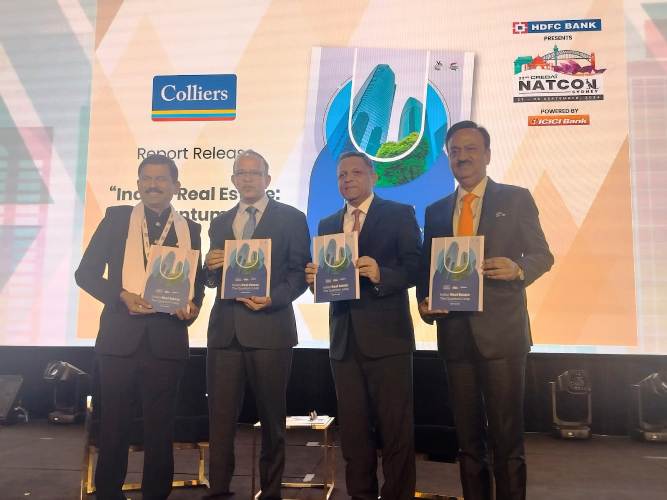- Six salient growth levers include urbanization, infrastructure augmentation, demographic shifts, digitalization, sustainability and investment diversification
- Urbanization & median age likely to be >50% and ~40 years by 2050, solidifying growth in office, residential and retail markets
- Emerging segments such as senior living, co-living and data centers to enter high growth trajectory in the upcoming decades
Sydney, September 23, 2024: India continues to be the fastest growing economy driven by strong domestic demand, improving business environment and supportive as well as forward-looking developmental policy initiatives. As India heads towards its centenary year of independence, real estate will play a pivotal role in economic growth trajectory of the country. This long-term growth in real estate is underpinned by six salient growth levers which includes, rapid urbanization, infrastructure development, digitalization, demographic shifts, sustainability and investment diversification; all of which will form the bedrock for a quantum leap in Indian real estate by 2047. These long-term growth ingredients will be pivotal in the expansion of Indian real estate – from under a trillion currently, to potentially a USD 10 trillion market by 2047, accounting for a 14-20% share in the country’s GDP.
The interplay between real estate and India’s economic growth journey over the next few decades is explored in the latest report “Indian Real estate: The Quantum Leap” by Colliers in collaboration with the Confederation of Real Estate Developers’ Associations of India (CREDAI) and released at the CREDAI NATCON event in Sydney. Most importantly, the quantum leap will create multiple real estate hotspots in its wake. Along the accelerated journey till 2047, various real estate segments will evolve and continue to proliferate, growing and maturing by varying degrees. Core assets such as office & residential real estate are likely to mature further and alternative assets such as data centers & senior living will embark upon strong growth trajectories. Market consolidation, fair-pricing and institutionalization will become more pervasive across asset classes, especially in the industrial & warehousing segment.
Likely transformation of real estate segments in India (2024 to 2047)
|
Lifecycle Stage |
Nascent |
Growth |
Mature |
||||||
|
Scale |
1 |
2 |
3 |
4 |
5 |
6 |
7 |
8 |
9 |
|
Residential |
|
|
|
|
|
|
|
|
|
|
Office |
|
|
|
|
|
|
|
|
|
|
Industrial & Warehousing |
|
|
|
|
|
|
|
|
|
|
Retail |
|
|
|
|
|
|
|
|
|
|
Hospitality |
|
|
|
|
|
|
|
|
|
|
Data Centers |
|
|
|
|
|
|
|
|
|
|
Other alternate assets * |
|
|
|
|
|
|
|
|
|
Note: *Other alternate assets include – Senior living, co-living, etc. | Industry/real estate segment lifecycle stage is indicative and is represented by a broad scale ranging from 1-9 (1 being extremely nascent/emerging and 9 being fully mature)
Shifting demographics and rising urbanization to spur long-term real estate demand
With shifting demographic pattern in India, the median age is likely to increase from ~30 years to ~40 years by 2050. Further, half of the Indian population is projected to live in urban agglomerations by 2050. With rapid urbanization and supporting factors like infrastructure growth & employment opportunities, real estate traction is likely to expand beyond the tier I cities and create dispersed growth centers in smaller towns & cities. Peripheral areas of established cities and tier II & III cities of the country will particularly witness accelerated real estate development across asset classes.
Shifting demographics will drive real estate activity, especially in housing and retail asset classes. With a significant portion of the Indian population likely to fall in the sweet spot of ‘First-time homebuyer’ age-bracket, healthy traction across housing categories is expected in the next few decades. Additionally, population with a significant share of older people can potentially speed up investments in the senior living market.
“With the interplay of dynamic factors such as rapid urbanization, rising median age, and technological advancements, we are on the brink of a quantum leap, entering a new era of growth and diversification. By 2047, an estimated 50% of India’s population will reside in urban centers, creating unprecedented demand across residential, office, and retail spaces. Alternative segments like senior living, co-living, and data centers will also witness exponential growth, driven by evolving consumer preferences and technological integration, with a focus on sustainability and energy efficiency becoming a standard across developments. As India navigates this exciting trajectory, the real estate sector will continue to attract institutional investments, fostering transparency, fair pricing, and global competitiveness. Being a leading industry body, CREDAI looks forward to working with various stakeholders to ensure that Indian real estate witnesses sustained and sustainable growth in the decades to come,” said Boman Irani, President, CREDAI National.
“India has set its sight on becoming a USD 10 trillion real estate market, driven by the sector’s ability to adapt and innovate. Landmark initiatives such as RERA and REIT regulations have enhanced transparency, improved investor confidence, and streamlined operations across the sector. These reforms, alongside critical programs like PMAY and Gati Shakti, are creating a conducive environment for sustained real estate development. The government’s focus on affordable housing, infrastructure modernization, and industrial corridors have transformed both urban and rural landscapes, driving growth beyond traditional hubs. This transformation is creating vibrant opportunities for developers, investors, and homebuyers alike. As we move forward, real estate will continue to be a catalyst for employment generation, economic resilience, and sustainable urbanization, reinforcing its role as a key pillar in India’s economic growth story,” said Manoj Gaur, Chairman, CREDAI National.
“As India commences on a period of expansion across most economic sectors, real estate is set for a ‘Quantum Leap’, with multiple growth opportunities arising along the accelerated journey phase. Favorable demographics and urbanization trends are likely to accentuate the emergence of over hundred – million plus cities by 2047. This in turn presents a case for emergence of multiple real estate hotspots dispersed across the country. Residential, office and retail segments, particularly, are expected to mature significantly in the next few decades, creating substantial opportunities for investors, developers and occupiers,” said Badal Yagnik, Chief Executive Officer, Colliers India
Infrastructure enhancement & supportive regulatory framework, imperative for fostering long-term real estate growth
Infrastructure augmentation and policy-level push have enabled the Indian real estate to sail through multiple ebbs and flows of property cycles. Throughout last few decades, key regulatory frameworks and acts such as the RERA Act, PMAY, and REIT Regulations have provided a boost to investor and end-user participation. Policies and regulations for Logistics and Data Centers have been instrumental in the accelerated growth of newer real estate frontiers. Furthermore, flagship programmes such as the Golden Quadrilateral Project, PM Gati Shakti Master Plan, ‘Make in India’ Programme and National Infrastructure Pipeline have positively impacted multiple real estate segments across the country, particularly the industrial & warehousing segment. With high-volume freight movement along industrial corridors, we can anticipate amplified requirement for warehouses, logistics hubs, and manufacturing units across multiple smaller locations in the country.
Over the next few years, asset classes under REITs/SM REITs will expand beyond office and retail to include warehouses, hotels, and rent-yielding residential properties. In the long-term, such financing avenues will become prevalent in alternate real estate verticals such as data centers, hospitals, educational institutes, senior and student living accommodations etc.
Alternate investments to become mainstream
Over the years, driven by strong domestic growth prospects, improvements in ease of doing business, and continual FDI relaxations, foreign capital inflow has grown significantly across diverse sectors. Institutional investments in the real estate sector in the last decade has crossed USD 60 billion, with majority being funded by foreign players. The anticipated spurt in foreign capital and equally strong contribution from domestic investors will fast-track the adoption of alternate funding strategies in Indian real estate. Green financing in the form of bonds & credit issuances and relatively newer financing avenues such as social-impact, distressed, special situation, and venture capital funds will become more prevalent in the next few years.
Digitalization & Sustainability will be the central themes in the future of real estate
Over the next few years, the Indian real estate sector will increasingly embrace digitalization across aspects ranging from planning, design & construction to property & facilities management. PropTech and Metaverse are likely to mature and elevate Indian real estate to global standards of operational efficiency, transparency and accountability. Increased data consumption, growing internet penetration, rise of online services, digitalization of businesses, and stricter adherence to data localization regulations are expected to spur demand for co-location and edge data centers closer to demand hubs.
Advanced technologies will also play a major role in decarbonizing the real estate sector. With focus on built spaces, developers will incorporate sustainable elements at every stage of construction. Green-certifications in the office market will particularly become a hygiene-factor and green-adoption levels are likely to increase from about 60-70% to almost 100% over the next few years.
Corporate Comm India (CCI Newswire)



















